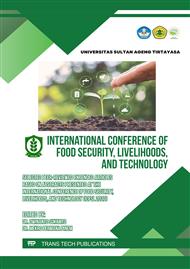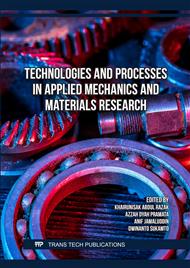[1]
World Health Organization, "Technical specifications for Pressure Swing Adsorption (PSA) Oxygen Plants," Interim Guid., no. June, p.1–5, 2020.
Google Scholar
[2]
B. Feng, J. Song, Z. Wang, N. Dewangan, S. Kawi, and X. Tan, "CFD modeling of the perovskite hollow fiber membrane modules for oxygen separation," Chem. Eng. Sci., vol. 230, no. xxxx, p.116214, 2021.
DOI: 10.1016/j.ces.2020.116214
Google Scholar
[3]
S. O. Lai, K. C. Chong, and W. J. Lau, Prospects of nanocomposite membranes for nitrogen and oxygen enrichment. Elsevier Inc., 2020.
Google Scholar
[4]
E. Akulinin, O. Golubyatnikov, D. Dvoretsky, and S. Dvoretsky, "Optimization and analysis of pressure swing adsorption process for oxygen production from air under uncertainty," Chem. Ind. Chem. Eng. Q., vol. 26, no. 1, p.89–104, 2020.
DOI: 10.2298/ciceq190414028a
Google Scholar
[5]
J. C. Santos, F. D. Magalhães, and A. Mendes, "Contamination of zeolites used in oxygen production by PSA: Effects of water and carbon dioxide," Ind. Eng. Chem. Res., vol. 47, no. 16, p.6197–6203, 2008.
DOI: 10.1021/ie800024c
Google Scholar
[6]
S. Farooq, D. M. Ruthven, and H. A. Boniface, "Numerical simulation of a pressure swing adsorption oxygen unit," Chem. Eng. Sci., vol. 44, no. 12, p.2809–2816, 1989.
DOI: 10.1016/0009-2509(89)85090-0
Google Scholar
[7]
A. M. M. Mendes, C. A. V. Costa, and A. E. Rodrigues, "Oxygen separation from air by PSA: Modelling and experimental results Part I: Isothermal operation," Sep. Purif. Technol., vol. 24, no. 1–2, p.173–188, 2001.
DOI: 10.1016/s1383-5866(00)00227-6
Google Scholar
[8]
J. G. Jee, M. K. Park, H. K. Yoo, K. Lee, and C. H. Lee, "Adsorption and desorption characteristics of air on zeolite 5A, 10X, and 13X fixed beds," Sep. Sci. Technol., vol. 37, no. 15, p.3465–3490, 2002.
DOI: 10.1081/ss-120014437
Google Scholar
[9]
M. Mofarahi, J. Towfighi, and L. Fathi, "Oxygen separation from air by four-bed pressure swing adsorption," Ind. Eng. Chem. Res., vol. 48, no. 11, p.5439–5444, 2009.
DOI: 10.1021/ie801805k
Google Scholar
[10]
C. S. Chang, S. H. Ni, H. S. Yang, and C. T. Chou, "Simulation study of separating oxygen from air by pressure swing adsorption process with semicylindrical adsorber," J. Taiwan Inst. Chem. Eng., vol. 120, p.67–76, 2021.
DOI: 10.1016/j.jtice.2021.03.027
Google Scholar
[11]
M. S. A. Baksh, E. S. Kikkinides, and R. T. Yang, "Lithium Type X Zeolite as a Superior Sorbent for Air Separation," Sep. Sci. Technol., vol. 27, no. 3, p.277–294, 1992.
DOI: 10.1080/01496399208018880
Google Scholar
[12]
S. U. Rege and R. T. Yang, "Limits for Air Separation by Adsorption with LiX Zeolite," Ind. Eng. Chem. Res., vol. 36, no. 12, p.5358–5365, 1997.
DOI: 10.1021/ie9705214
Google Scholar
[13]
K. P. Kostroski and P. C. Wankat, "High recovery cycles for gas separations by pressure-swing adsorption," Ind. Eng. Chem. Res., vol. 45, no. 24, p.8117–8133, 2006.
DOI: 10.1021/ie060566h
Google Scholar
[14]
X. Zheng, Y. Liu, W. Liu, H. Zhang, and Y. Li, "Two-dimensional modeling of the pressure swing adsorption process," Adv. Mater. Res., vol. 233–235, p.1379–1383, 2010.
DOI: 10.4028/www.scientific.net/amr.233-235.1379
Google Scholar
[15]
D. Ferreira, P. Bárcia, R. D. Whitley, and A. Mendes, "Single-Stage Vacuum Pressure Swing Adsorption for Producing High-Purity Oxygen from Air," Ind. Eng. Chem. Res., vol. 54, no. 39, p.9591–9604, 2015.
DOI: 10.1021/acs.iecr.5b02151
Google Scholar
[16]
Y. Wang, Y. An, Z. Ding, Y. Shen, Z. Tang, and D. Zhang, "Integrated VPSA Processes for Air Separation Based on Dual Reflux Configuration," Ind. Eng. Chem. Res., vol. 58, no. 16, p.6562–6575, 2019.
DOI: 10.1021/acs.iecr.8b06272
Google Scholar
[17]
S. W. Chai, M. V. Kothare, and S. Sircar, "Rapid pressure swing adsorption for reduction of bed size factor of a medical oxygen concentrator," Ind. Eng. Chem. Res., vol. 50, no. 14, p.8703–8710, 2011.
DOI: 10.1021/ie2005093
Google Scholar
[18]
X. Yang et al., "Two-dimensional modeling of pressure swing adsorption (PSA) oxygen generation with radial-flow adsorber," Appl. Sci., vol. 9, no. 6, 2019.
DOI: 10.3390/app9061153
Google Scholar



